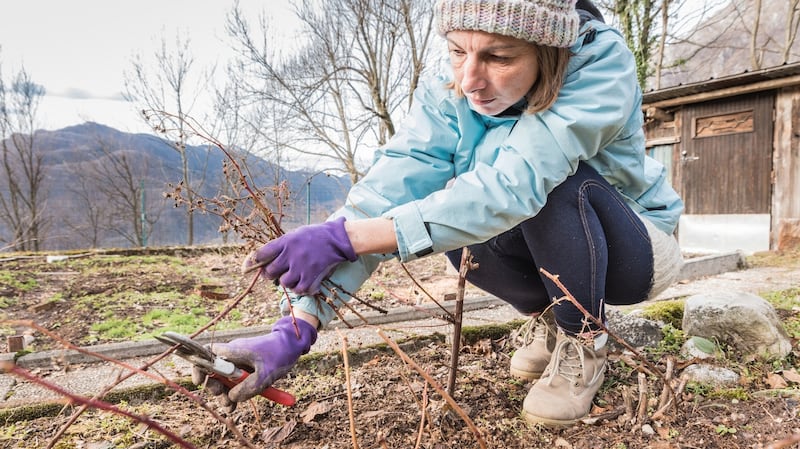Feel like getting your hands dirty? Here are ten ways to kick off the new gardening year.

Grow your own
Seed potatoes are in very high demand this year so order them as soon as possible before stocks of hard-to-get/popular varieties run out.
One of my new favourites is Carolus, a very high-yielding, flavoursome, main crop variety with excellent blight resistance available to order as organic seed from fruithillfarm.com. Another is Vitabella, a great early/second-early “salad” potato prized for its outstanding flavour and firm golden flesh as well as its productivity and great blight resistance. Both are an excellent choice for organic gardeners who want to avoid the use of fungicides.
For best results, pre-sprout/chit the tubers by spreading them out, “eyes” up, in a shallow tray or cardboard box. Placed in a cool, bright but frost-free spot, they will slowly start into growth and can be planted out into the garden from mid-March or earlier again in the polytunnel/glasshouse.
Recommended Irish suppliers of seed potatoes include Dublin-based Mr Middleton (mrmiddleton.com), Sligo-based quickcrop.ie and all good Irish garden centres.
Work on the roses
Lenten roses (Helleborus x hybridus) are one of the stars of the late winter- early spring garden with exquisitely pretty, weather-resilient, long-lasting flowers in shades of plum, pink, purple, cream and yellow.
To show off the beautiful blooms of these very long-lived perennial plants to their best – as well as to avoid the risk of disfiguring or damaging plant diseases such as hellebore leaf spot spreading to the emerging foliage – it’s best to completely cut away the old, damaged leaves at this time of year.
Use a sharp secateurs to do this, making sure to carefully bag and remove any pruned material while taking care not to accidentally damage the plant’s emerging flower buds.
A cut above the rest
Late January is also the time to start pruning many different kinds of roses in order to encourage the production of lots of new, strong, healthy growth (and thus lots of flowers come summertime).
Wear a pair of sturdy gloves and use a clean, sharp secateurs or loppers to do this, making sure to collect and bag all fresh prunings along with any dead/fallen leaves around the base of the plant that might act as a potential source of disease.
While the exact pruning regimen will vary according to the type of rose (see rhs.co.uk for specific instructions), a good rule of thumb is to start by removing all dead, diseased or damaged branches and to finish off with a generous mulch of well-rotted manure or organic matter around the base of the plant, making sure that it doesn't make direct contact with the stems.
Trim winter grasses
Certain species of ornamental grasses really benefit from being cut back hard at this time of year, not only as a way of giving the plants a new lease of life but also to tidy them up and get rid of any dead, decaying or damaged leaves that may be harbouring pests and diseases.
Species suitable for this sort of late-winter trim include the statuesque Stipa gigantea (commonly known as ‘golden oats’); Calamagrostis x acutiflora ‘Karl Foerster’ (a deciduous species prized for its elegantly upright growth habit); pampas grass (Cortaderia selloana); and the delicately pretty Deschampsia cespitosa.
Always wear sturdy garden gloves to protect your hands while doing this (the leaves of some species of ornamental grass can give a nasty cut similar to a paper-cut), using a clean, sharp, long-handled garden shears or loppers to clip plants back hard to just above any emerging new growth.
Start on the sweet pea
If you’re dreaming of armfuls of sweetly-scented flowers to pick from your garden or allotment this summer, then few are lovelier or more intensely perfumed than sweet pea.
Late winter is a great time to start growing your own plants from seed, for transplanting into a sunny, open, very fertile spot in the garden or allotment from mid-March. For best results, pre-chit the seeds by placing them in a small, lidded container on some crumpled damp kitchen paper.
Place this container somewhere cool, bright and frost-free until you see both the baby root radicles and stems beginning to emerge from each seed, then very gently sow each seed 10-12mm deep into a small pot/root trainer filled with a good quality multipurpose compost, water lightly, label (listing the variety, supplier, sowing date) and place these somewhere bright and cool but frost-free to grow on.
An unheated glasshouse/polytunnel or cool porch is ideal for this purpose (a typical kitchen or living room is too warm). Take very careful precautions against slugs, snails and rodents, which love to feed on the tender young shoots and/or seed of this very decorative, hardy annual climber.
Once the young plants have reached a height of 10-15cm, pinch out their growing tips to encourage strong, bushy, productive plants. Sweet pea seed is available to order from all good Irish garden centres as well as online suppliers such as seedaholic.com and mrmiddleton.ie
Chop away at climbers
If you grow the ornamental climber known as wisteria in your garden, then late winter is the time to give established plants their annual winter pruning, using a clean, sharp secateurs to cut the lateral/side shoots along the main stems back to two-three healthy buds. Twice-yearly pruning – wisterias should also be pruned in summer – not only keeps this sprawling climber in shape but also helps to encourage the plentiful production of its dramatically beautiful, white, pink, lavender-blue or lilac-coloured flowers, which appear in late spring/early summer.

Tackle fruit trees and bushes
January/early February is a great time of year to prune many kinds of fruit bushes and fruit trees in order to encourage the production of lots of new fruit-bearing branches come springtime.
Blackcurrant bushes: use a sharp, clean secateurs or loppers to cut away any weak, spindly branches along with roughly a third of the plant's shoots (choose the thickest, oldest branches).
Red and white currant bushes: remove any weak or spindly growth and then cut back/ shorten individual branches by about a quarter.
Established gooseberry bushes: use a sharp secateurs/loppers to remove dead/ damaged and low growing branches, cutting back the tips of main branches by a quarter and then cutting all side shots back to within 1-3 buds from the base.
Autumn-fruiting (primocane) varieties of raspberry: cut half the canes back to ground level and the other half to a metre above ground level (this will give you a staggered harvest).
Summer-fruiting raspberries: these should have received their main pruning last autumn. Cut the tips of the canes to a bud that's within 10cm of the highest training wire.
Free-standing and standard apple and pear trees: cut away any dead, damaged, diseased (known as the three Ds) or crossing branches, then cut back new growth on main branches by approximately one-third.
Plum, almond or cherry trees: hold off pruning until summer to avoid the risk of disease entering through the pruning cuts. For more detailed, step-by-step pruning instructions, see rhs.co.uk
Spice it up
Chilli peppers are famously slow to germinate and require a long growing season in order to be properly productive, so if you’re thinking of growing your own this year, then you’ll need to sow seed in the coming weeks (Tip: the seed also needs a good, steady bottom heat of around 25-30 degrees Celsius for optimum germination, so use an electric propagator or place the seed tray/pot in a hot press).
Recommended seed suppliers include Cork-based Brown Envelope Seeds (brownenvelopeseeds.com), whose range includes the mild-flavoured 'Hungarian Hot Wax' and 'Bolivian Hairy', a very productive and reliably perennial variety famed for its fiery flavour.
Tool up
Take advantage of this relatively quiet time in the gardening year to repair, oil and sharpen any garden tools and to organise for garden machinery to be serviced or repaired.
If you plan on growing lots of plants from seed this spring, then check your supplies of compost, seed trays, pots, labels and garden fleece, clean down any propagating equipment and (if you own one) wash/tidy glasshouses and/or polytunnels and repair any broken panes, damaged windows or doors or tears/rips to the polythene covering (use self-adhesive repair tape for the latter).
Winter colour
Yes, it’s January but even at this time of year there are still some species of shrubs, climbers, perennials and bulbs that can be used to add a very welcome burst of colour to the garden.
Examples include witch hazel (Hamamelis) whose deeply-scented spidery flowers are one of the delights of the late-winter garden; mahonia (Mahonia x media and Mahonia japonica), architectural, evergreen shrubby species with bright-yellow, showy, perfumed flowers; the borderline-hardy daphnes (examples include Daphne odora, Daphne bholua ‘Jacqueline Postill’ and Daphne ‘Perfume Princess’), which are all prized for their intensely fragrant blooms; Lenten rose (Helleborus x orientalis, see above); varieties of Clematis cirrhosa (for mild, sheltered gardens) and many kinds of dainty bulbous species including the Algerian iris (Iris unguicalaris), winter aconites (Eranthis hyemalis), snowdrops (Galanthus), cyclamen (Cyclamen coum) and crocus (Crocus tommasinianus).
Stockists include all good Irish garden centres and specialist nurseries.












